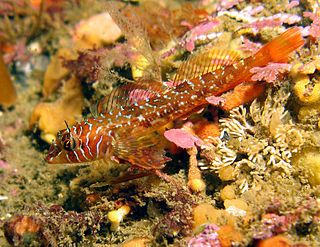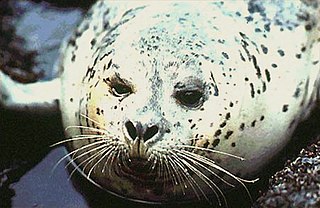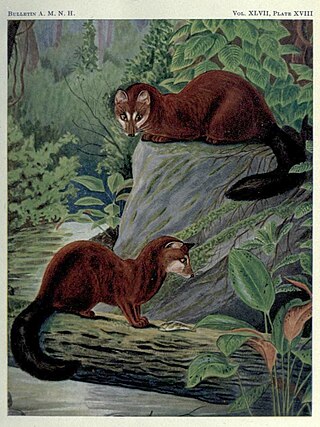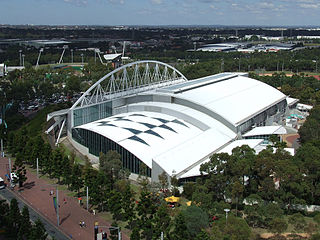
A gill is a respiratory organ that many aquatic organisms use to extract dissolved oxygen from water and to excrete carbon dioxide. The gills of some species, such as hermit crabs, have adapted to allow respiration on land provided they are kept moist. The microscopic structure of a gill presents a large surface area to the external environment. Branchia is the zoologists' name for gills.
The aquatic ape hypothesis (AAH), also referred to as aquatic ape theory (AAT) or the waterside hypothesis of human evolution, postulates that the ancestors of modern humans took a divergent evolutionary pathway from the other great apes by becoming adapted to a more aquatic habitat. While the hypothesis has some popularity with the lay public, it is generally ignored or classified as pseudoscience by anthropologists.

Limnology is the study of inland aquatic ecosystems. The study of limnology includes aspects of the biological, chemical, physical, and geological characteristics of fresh and saline, natural and man-made bodies of water. This includes the study of lakes, reservoirs, ponds, rivers, springs, streams, wetlands, and groundwater. Water systems are often categorized as either running (lotic) or standing (lentic).

Aquatic plants are plants that have adapted to living in aquatic environments. They are also referred to as hydrophytes or macrophytes to distinguish them from algae and other microphytes. A macrophyte is a plant that grows in or near water and is either emergent, submergent, or floating. In lakes and rivers, macrophytes provide cover for fish, substrate for aquatic invertebrates, produce oxygen, and act as food for some fish and wildlife.

In ecology, a marsh is a wetland that is dominated by herbaceous plants rather than by woody plants. More in general, the word can be used for any low-lying and seasonally waterlogged terrain. In Europe and in agricultural literature low-lying meadows that require draining and embanked polderlands are also referred to as marshes or marshland.

An aquatic animal is any animal, whether vertebrate or invertebrate, that lives in bodies of water for all or most of its lifetime. Aquatic animals generally conduct gas exchange in water by extracting dissolved oxygen via specialised respiratory organs called gills, through the skin or across enteral mucosae, although some are evolved from terrestrial ancestors that re-adapted to aquatic environments, in which case they actually use lungs to breathe air and are essentially holding their breath when living in water. Some species of gastropod mollusc, such as the eastern emerald sea slug, are even capable of kleptoplastic photosynthesis via endosymbiosis with ingested yellow-green algae.
World Aquatics, formerly known as FINA, is the international federation recognised by the International Olympic Committee (IOC) for administering international competitions in water sports. It is one of several international federations which administer a given sport or discipline for both the IOC and the international community. It is based in Lausanne, Switzerland.

Aquatic respiration is the process whereby an aquatic organism exchanges respiratory gases with water, obtaining oxygen from oxygen dissolved in water and excreting carbon dioxide and some other metabolic waste products into the water.

The European Aquatics Championships is the continental Aquatics championship for Europe, which is organised by LEN—the governing body for aquatics in Europe. The Championships are currently held every two years and since 2022, they have included 5 aquatics disciplines: swimming, diving, synchronised swimming, open water swimming and high diving. Prior to 1999, the championships also included water polo, which beginning in 1999 LEN split-off into a separate championships. The open water events are not held during the Olympic year.

Phoca is a genus of the earless seals, within the family Phocidae. It now contains just two species, the common seal and the spotted seal. Several species formerly listed under this genus have been split into the genera Pusa, Pagophilus, and Histriophoca. Until recently, Phoca largha has been considered a subspecies of Phoca vitulina but now is considered its own species. For this reason, the fossil history of the genus is unclear, and it has formerly been used as wastebasket taxon for a number of fossils of uncertain affinity.

The spotted turtle, the only species of the genus Clemmys, is a small, semi-aquatic turtle that reaches a carapace length of 8–12 cm (3.1–4.7 in) upon adulthood. Their broad, smooth, low dark-colored upper shell, or carapace, ranges in its exact colour from black to a bluish black with a number of tiny yellow round spots. The spotting patterning extends from the head, to the neck and out onto the limbs. Sexually mature males have a concave plastron and a long, thick tail. By contrast, sexually mature females possess a flat plastron and have a tail that is noticeably shorter and thinner than that of mature males. Mature males also have a dark iris and face; females typically have a yellow or orange iris and a similarly coloured face that is distinctly lighter than the males'. Juveniles appear female-like in this regard, and at maturity males begin to develop darker features.
An aquatic ecosystem is an ecosystem found in and around a body of water, in contrast to land-based terrestrial ecosystems. Aquatic ecosystems contain communities of organisms—aquatic life—that are dependent on each other and on their environment. The two main types of aquatic ecosystems are marine ecosystems and freshwater ecosystems. Freshwater ecosystems may be lentic ; lotic ; and wetlands.

The aquatic genet, also known as the fishing genet, is a genet that has only been recorded in the northeast of the Democratic Republic of the Congo. Since it is only known from about 30 specimens in zoological collections, it had been listed as Data Deficient on the IUCN Red List since 1996, as it is considered one of Africa's rarest carnivores. In 2015, it has been reassessed as Near Threatened.

Terrestrial animals are animals that live predominantly or entirely on land, as compared with aquatic animals, which live predominantly or entirely in the water, and semiaquatic animals, which rely on both aquatic and terrestrial habitats. Some groups of insects are terrestrial, such as ants, butterflies, earwigs, cockroaches, grasshoppers and many others, while other groups are partially aquatic, such as mosquitoes and dragonflies, which pass their larval stages in water.

The Sydney Olympic Park Aquatic Centre (SOPAC), formerly Sydney International Aquatic Centre (SIAC), is a swimming venue located in the Sydney Olympic Park in Sydney, New South Wales, Australia. Built in 1994, the SOPAC was a major venue for the 2000 Summer Olympics as it hosted the swimming, diving, synchronized swimming, the medal events for water polo, and the swimming portion of the modern pentathlon competitions. The SOPAC has since been a host venue for numerous schools and swimming associations around New South Wales. Currently, it has most notably been the venue for the annual CAS Swimming Championships. It is also scheduled to be the site of the 2022 Duel in the Pool. The SOPAC also includes a swim shop at the entry of the arena, a play area, a health club and operates swimming classes for all ages.
The microbial food web refers to the combined trophic interactions among microbes in aquatic environments. These microbes include viruses, bacteria, algae, heterotrophic protists. In aquatic ecosystems, microbial food webs are essential because they form the basis for the cycling of nutrients and energy. These webs are vital to the stability and production of ecosystems in a variety of aquatic environments, including lakes, rivers, and oceans. By converting dissolved organic carbon (DOC) and other nutrients into biomass that larger organisms may eat, microbial food webs maintain higher trophic levels. Thus, these webs are crucial for energy flow and nutrient cycling in both freshwater and marine ecosystems.

The Olympic Aquatics Stadium was a temporary aquatics center in the Barra Olympic Park in Rio de Janeiro. The venue hosted the swimming events, Synchronized swimming finals and water polo finals at the 2016 Summer Olympics, and the para-swimming events for the 2016 Summer Paralympics.













